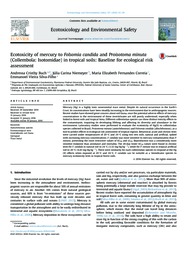Ecotoxicity of mercury to Folsomia candida and Proisotoma minuta (Collembola: isotomidae) in tropical soil: baseline for ecological risk assessment.
Ecotoxicity of mercury to Folsomia candida and Proisotoma minuta (Collembola: isotomidae) in tropical soil: baseline for ecological risk assessment.
Author(s): BUCH, A. C.; NIEMEYER, J. C.; CORREIA, M. E. F.; SILVA FILHO, E. V.
Summary: Mercury (Hg) is a highly toxic nonessential trace metal. Despite its natural occurrence in the Earth's Crust, its concentrations have been steadily increasing in the environment due to anthropogenic sources. Recent studies have showed great concern about soil fauna, once the potential adverse effects of mercury concentrations in the environment of these invertebrates are still poorly understood, especially when linked to forest soils and tropical biota. Different collembolan species can show distinct toxicity effects to the contaminants, impairing its developing lifelong and affecting its diversity and abundance in the environment. Laboratory studies were performed to evaluate the ecotoxicity of Hg(II) to collembolan species collected in Brazil, Proisotoma minuta (autochthonous) and Folsomia candida (allochthonous), as a tool to predict effects in ecological risk assessment of tropical regions. Behavioral, acute and chronic tests were carried under temperatures of 20 °C and 24 °C using two test soils, natural and artificial, spiked with increasing mercury concentrations. F. candida was more sensitive to mercury contamination than P. minuta, presenting the most restrictive values of EC50 and LC50. Reproduction was a considerably more sensitive endpoint than avoidance and mortality. The 28-day lower EC50 values were found in chronic tests for F. candida in natural soil to 24 °C (3.32 mg Hg kg?1), while for P. minuta was in tropical artificial soil to 20 °C (4.43 mg Hg kg?1). There were similarity for each collembolan species to respond at the Hg(II) effects when exposed at 20 °C and 24 °C. F. candida can be suitable as a bioindicator species to mercury ecotoxicity tests in tropical forest soils.
Publication year: 2016
Types of publication: Journal article
Unit: Embrapa Agrobiology
Observation
Some of Embrapa's publications are published as ePub files. To read them, use or download one of the following free software options to your computer or mobile device. Android: Google Play Books; IOS: iBooks; Windows and Linux: Calibre.
Access other publications
Access the Agricultural Research Database (BDPA) to consult Embrapa's full library collection and records.
Visit Embrapa Bookstore to purchase books and other publications sold by Embrapa.

